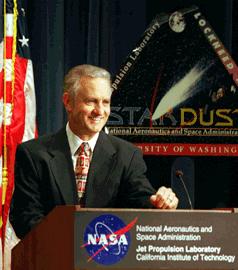STARDUST Status Report
February 12, 1999

Ken
Atkins
STARDUST Project Manager
STARDUST is on its way to Wild 2! After a one-day delay because of a range
safety interaction with the Delta 2's C-band transponder, the launch was
accomplished with a virtual "bullseye" on the targeted outbound trajectory.
All injection parameters were well within the 3-sigma dispersion. The
second stage "rocket camera" provided a spectacular view of the ride into
space on a beautiful, cloudless Florida day. This triggered a big press
response with great national coverage. The time of launch was 4:04:15.238
EST, against the instantaneous window. Spacecraft separation came at
about 28 minutes after lift off.
After separation from the Star-37 upper stage, STARDUST did its own
de-spin, deployed the solar arrays, got to its on-sun attitude, and
performed a status check to be ready to telemeter data as soon as possible.
Signal acquisition was near the earliest possible time, just after 5 P.M. EST
and showed that the spacecraft was de-spun and on the sun. STARDUST passed
the moon the next day at 12:16 p.m. EST at a distance of 33,200 miles and
speed of almost 12,000 mph. Hand-offs from Canberra to Madrid tracking was
very smooth.
The spacecraft is demonstrating excellent performance in all respects.
Temperatures are tracking close to those from system thermal vacuum
testing, but are generally a little warmer, which should provide some
margin for aphelion when the spacecraft is at is farthest distance from
the Sun. Initial trajectory tracking indicates that no
trajectory correction maneuver (TCM) is required for February 22 as
originally called for by the nominal flight plan. Tracking data will
continue to accrue, and an assessment early next week will confirm whether
a maneuver will be needed on Feb 22, or whether it should be simply delayed
(which requires re-coordination of Deep Space Network (DSN) time) until better
correlation of the actual accelerations with those predicted can be achieved.
Current plans indicate we may turn on the Dust Flux Monitor (DFM) next week
and the Cometary & Interstellar Dust Analyzer (CIDA) within two weeks. We
are also looking at turning on the Navigation Camera and imaging the moon,
if we do not need the Feb 22 TCM.
It's great to have the "voyage" begun. I'm sure everyone is enjoying the
pictures and new "movies" on the Web Site. It's great to be able to see
where STARDUST is at any time.
After the launch, Don Brownlee and I made a "pilgrimage" back to the launch
pad. It was impressive to see that place where so much of our last 3 1/2
years work had been just hours before...now empty. Launch Pad 17-A (SLC-17A)
holds an important historic role in being the place where the first attempt
to bring back cometary material launched off the planet . And other robotic
explorers have also departed the planet from there: Mars Global Surveyor
and Mars Climate Orbiter. It was a moving experience.
And, now all the "passengers" on the chip are in deep space, beyond the
moon and moving outbound. Let's have a wondrous journey of adventure and
discovery.
For more information on the STARDUST mission - the first ever comet sample
return mission - please visit the STARDUST home page:
http://stardust.jpl.nasa.gov
